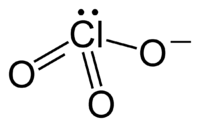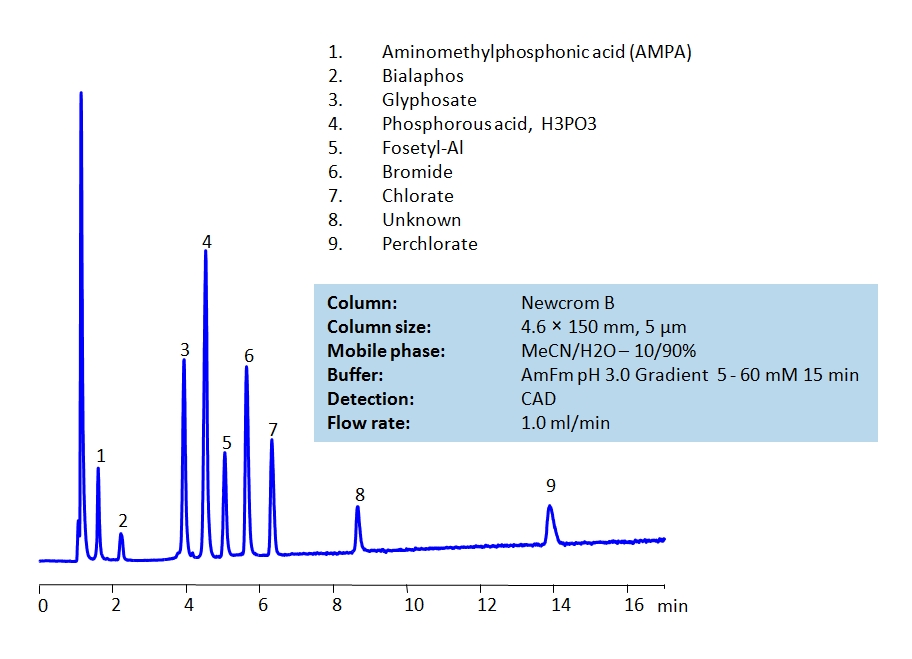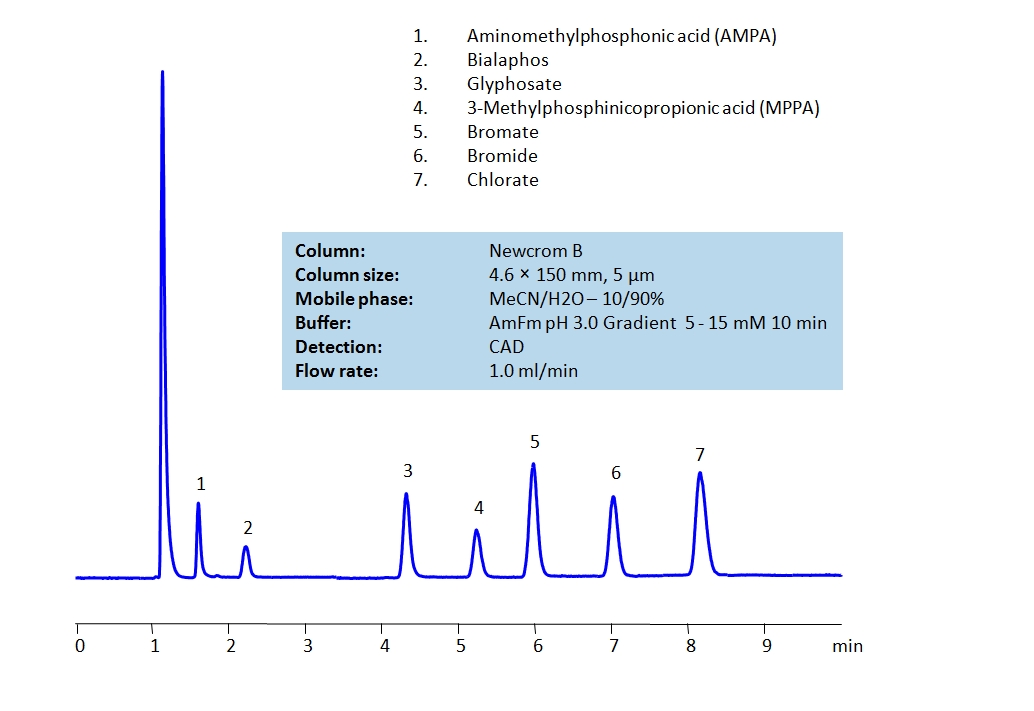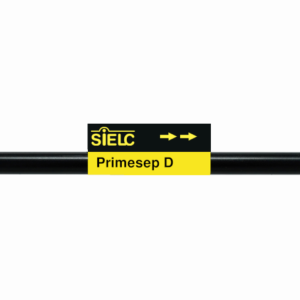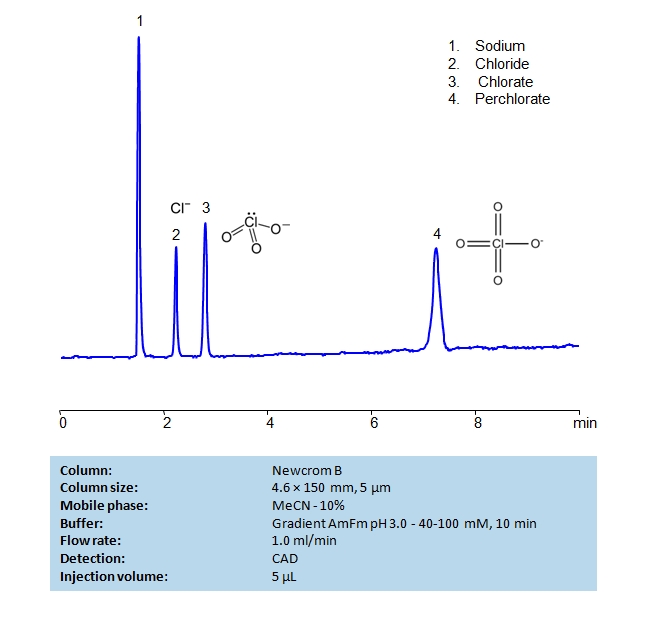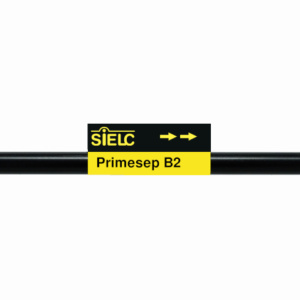| CAS Number | 14866-68-3 |
|---|---|
| Molecular Formula | ClO3 |
| Molecular Weight | 83.450 |
| InChI Key | XTEGARKTQYYJKE-UHFFFAOYSA-M |
| LogP | -4.63 |
| Synonyms |
|
Applications:
HPLC Separation of Polar Pesticides on Newcrom B Column
November 19, 2020
Pesticide is a more generic term that includes herbicides, fungicides and insecticides in its definition. Herbicides are used to control unwanted plants, they are also known as weedkillers. Insecticides are used to kill insects. Fungicides are used to kill parasitic fungi. All are heavily used in agriculture. By using HPLC, many different pesticides can be separated and their retention characteristics controlled using the Newcrom B mixed-mode column.
| Column | Newcrom B, 4.6×150 mm, 5 µm, 100A |
| Mobile Phase | MeCN/H2O – 10/90% |
| Buffer | AmFm pH 3.0 Gradient 5 – 60 mM 15 min |
| Flow Rate | 1 ml/min |
| Detection | CAD |
| Column | Newcrom B, 4.6×150 mm, 5 µm, 100A |
| Mobile Phase | MeCN/H2O – 10/90% |
| Buffer | AmFm pH 3.0 Gradient 5 – 15 mM 10 min |
| Flow Rate | 1 ml/min |
| Detection | CAD |
| Class of Compounds | Pesticides, Herbicides, Fungicides, Insecticides |
| Analyzing Compounds | Aminomethylphosphonic acid (AMPA), Bialaphos, Glyphosate, Phosphorous acid H3PO3, Fosetyl-Al, Bromide, Chlorate, Perchlorate, 3-Methylphosphinicopropionic acid (MPPA), Bromide |
Application Column
Newcrom B
The Newcrom columns are a family of reverse-phase-based columns. Newcrom A, AH, B, and BH are all mixed-mode columns with either positive or negative ion-pairing groups attached to either short (25 Å) or long (100 Å) ligand chains. Newcrom R1 is a special reverse-phase column with low silanol activity.
Select optionsAminomethylphosphonic acid (AMPA)
Bialaphos
Bromate
Bromide
Chlorate
Fosetyl-Al
Glyphosate
Perchlorate
Phosphorous acid
Sodium Bromate

Separation of Chlorate, Perchlorate, and Phosphonate Ions on Primesep D Column
June 11, 2020
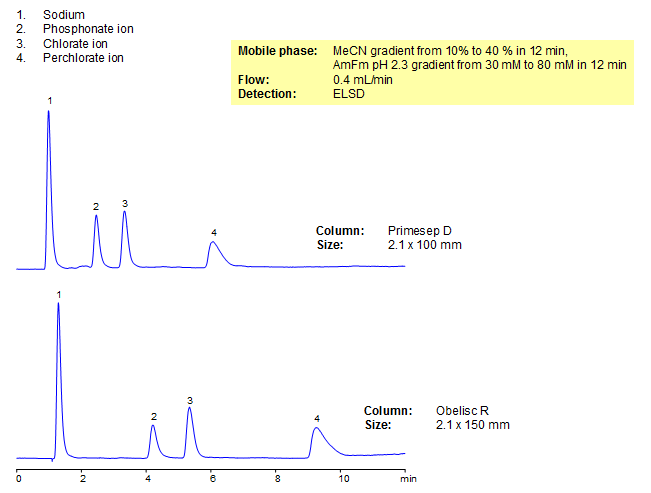
The ionic forms of Chlorate, Perchlorate, and Phosphonates are useful in many industries including medicine, paper and use in explosives. Due to their lack of UV activity, an ELSD was used to detect both the anions and cations of all three sodium salts. The ions were retained on both Primesep D and Obelisc R columns. Primesep D is a reverse phase column with embedded basic ion-pairing groups. Obelisc R is also a reverse phase column, but can be additionally tuned due to embedded ionic groups and a hydrophobic chain.
| Column | Primesep D, 2.1×100 mm, 5 µm, 100A |
| Mobile Phase | Gradient MeCN – 10-40%, 12 min |
| Buffer | Gradient AmFm pH 2.3- 30-80 mM, 12 min |
| Flow Rate | 0.4 ml/min |
| Detection | ELSD |
| Class of Compounds |
Hydrophilic, Ionizable |
| Analyzing Compounds | Chlorate, Perchlorate, Phosphonate Ions |
Application Column
Primesep D
Column Diameter: 2.1 mm
Column Length: 100 mm
Particle Size: 5 µm
Pore Size: 100 A
Perchlorate

HPLC Determination of Chloride, Chlorate and Perchlorate on Newcrom B Column
December 10, 2019
Main source of contamination of environment by perchlorates are rocket fuels, car airbags, and fireworks.
EPA developed regulation of the perchlorate level in drinking water which already adapted by several states.
The most convenient, universal and very sensitive way to measure perchlorate is chromatography.
SIELC developed a simple, rugged, and selective HPLC method which allows to measure perchlorate in different matrices including drinking water.
This method allows to measure simultaneously other chloro containing ions such as chloride, and chlorate.
The method shows high selectivity and specificity.
The mobile phase is a simple mixture of water acetonitrile and ammonium formate.
The column used in the analysis has advanced surface chemistry with long chain holding a terminal positively changed functional group.
| Column | Newcrom B, 4.6×150 mm, 5 µm, 100A |
| Mobile Phase | MeCN/H2O – 10/90% |
| Buffer | Gradient AmFm pH 3.0 – 40-100 mM , 10 min |
| Flow Rate | 1.0 ml/min |
| Detection | CAD |
| Class of Compounds | Ions, Hydrophilic, Ionizable |
| Analyzing Compounds | Sodium Chloride, Sodium Chlorate, Sodium Perchlorate |
Application Column
Newcrom B
The Newcrom columns are a family of reverse-phase-based columns. Newcrom A, AH, B, and BH are all mixed-mode columns with either positive or negative ion-pairing groups attached to either short (25 Å) or long (100 Å) ligand chains. Newcrom R1 is a special reverse-phase column with low silanol activity.
Select optionsChloride
Perchlorate
Sodium Chlorate

Separation of Chlorate, Perchlorate, and Phosphonate Ions on Obelisc R Column
July 30, 2015

The ionic forms of Chlorate, Perchlorate, and Phosphonates are useful in many industries including medicine, paper and use in explosives. Due to their lack of UV activity, an ELSD was used to detect both the anions and cations of all three sodium salts. The ions were retained on both Primesep D and Obelisc R columns. Primesep D is a reverse phase column with embedded basic ion-pairing groups. Obelisc R is also a reverse phase column, but can be additionally tuned due to embedded ionic groups and a hydrophobic chain.
| Column | Obelisc R, 2.1 x 50 mm, 5 µm, 100 A |
| Mobile Phase | Gradient MeCN – 10-40%, 12 min |
| Buffer | Gradient AmFm pH 2.3- 30-80 mM, 12 min |
| Flow Rate | 0.4 ml/min |
| Detection | ELSD |
| Class of Compounds |
Hydrophilic, Ionizable |
| Analyzing Compounds | Chlorate, Perchlorate, Phosphonate Ions |
Application Column
Obelisc R
Column Diameter: 2.1 mm
Column Length: 50 mm
Particle Size: 5 µm
Pore Size: 100 A
Perchlorate
Phosphonate
Sodium

HPLC Analysis of Basic Drugs and Acidic Counter-Ions by Mixed-Mode Chromatography
July 16, 2009
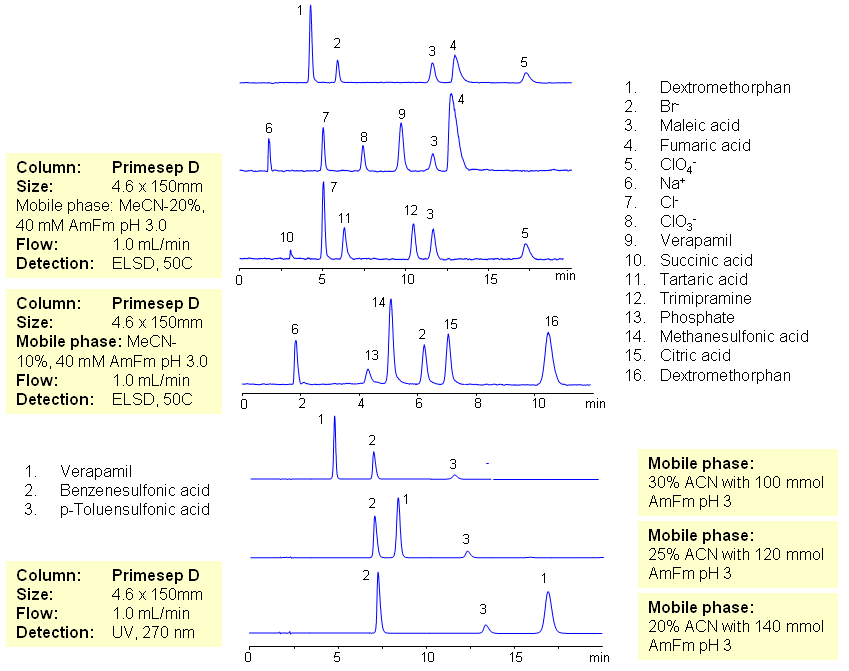
The majority of drugs in the pharmaceutical industry are administered in salt form. The presence of two counter-ions very often necessitates the use of two methods. The nature of these counterparts in drugs can be an inorganic cation and organic acid, inorganic anion and organic base, and organic cation and organic anion. Furthermore, the properties of the molecules will result in a differing stoichiometry. The task of simultaneous quantitation of counter-ions can be achieved by using mixed-mode columns. The general approach for analysis is based on properties of corresponding counter-ions. Hydrophobic basic drugs, like dextromethorphan, verapamil, trimipramine, and corresponding acidic counter-ions (chloride, chlorate, bromide, bromate, perchlorate, maleate, fumarate,tartrate, succinate, phosphate, citrate, benzosulfonate, toleuensulfonate) can be separated and quantitated in the same run on reversed-phase anion-exchange column. Basic hydrophobic drugs are retained by the reversed-phase mechanism, and counter-ions are retained by the reversed-phase and anion-exchange mechanism. Some polar counter-ions are retained only by the anion-exchange mechanism. Retention time and selectivity of HPLC separation of drugs and counter-ions can be achieved by changing the amount of acetonitrile and the amount of ions in the mobile phase. The detection technique depends on the properties of the counter-ions. In case of low or no UV activity, ELSD can be employed if the counter-ion forms a non-volatile salt with the mobile phase additive (ammonium formate). This HPLC method can be used for simultaneous quantitation of other basic drugs and counter-ions. The presence of two mechanisms of retention allows control over retention times of drug and counter-ion independently, and even allows a change of order of elution when necessary.
| Column | Primesep D , 4.6×150 mm, 5 µm, 100A |
| Mobile Phase | MeCN/H2O |
| Buffer | AmFm pH 3.0 |
| Flow Rate | 1.0 ml/min |
| Detection | ELSD, UV 270 |
| Class of Compounds | Ions, Hydrophilic, Hydrophobic, Base, Acids, Ionizable |
| Analyzing Compounds | Sodium Chloride, Sodium chloride, Sodium Chlorate, Sodium bromide, Sodium bromate, Perchloric Acid, Maleic Acid, Fumaric Acid, Tartaric Acid, Succinic Acid, Phosphoric Acid, Citric acid, Benzosulfonic acid, Dextromethorphan, Verapamil, Trimipramine |
Application Column
Primesep D
The Primesep family of mixed-mode columns offers a wide variety of stationary phases, boasting unprecedented selectivity in the separation of a broad array of chemical compounds across multiple applications. Corresponding Primesep guard columns, available with all stationary phases, do not require holders. SIELC provides a method development service available to all customers. Inquire about our specially-tailored custom LC-phases for specific separations.
Select optionsBromide
Chlorate
Chloride
Citric Acid
Dextromethorphan
Fumaric Acid
Maleic Acid
Organic Acids
Perchlorate
Phosphoric Acid
Pyrilamine
Succinic Acid
Tartaric Acid
Verapamil
p-Toluenesulfonic Acid (PTSA)
UV Detection

HPLC Separation of Chlorate and Bromate Ions
March 27, 2004
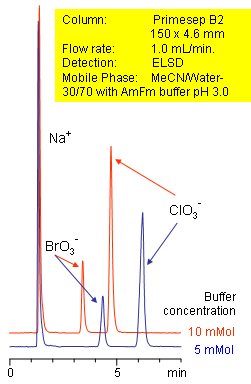
Primesep B2 separates chlorate and bromate by an ion-exchange mechanism. The anion-exchange properties of the column allow retention of hydrophilic compounds, and these properties can be adjusted by simply changing the ammonium formate buffer concentration. The HPLC separation uses a mobile phase of water, acetonitrile (MeCN, ACN) and ammonium formate with evaporative light scattering detection (ELSD).
| Column | Primesep B2, 4.6×150 mm, 5 µm, 100A |
| Mobile Phase | MeCN/H2O – 30/70% |
| Buffer | AmFm pH 3.0 |
| Flow Rate | 1.0 ml/min |
| Detection | CAD |
| Class of Compounds | Ions, Hydrophilic, Ionizable |
| Analyzing Compounds | Sodium Chlorate, Sodium Bromate |
Application Column
Primesep B2
The Primesep family of mixed-mode columns offers a wide variety of stationary phases, boasting unprecedented selectivity in the separation of a broad array of chemical compounds across multiple applications. Corresponding Primesep guard columns, available with all stationary phases, do not require holders. SIELC provides a method development service available to all customers. Inquire about our specially-tailored custom LC-phases for specific separations.
Select optionsChlorate
Sodium Bromate
Sodium Chlorate

